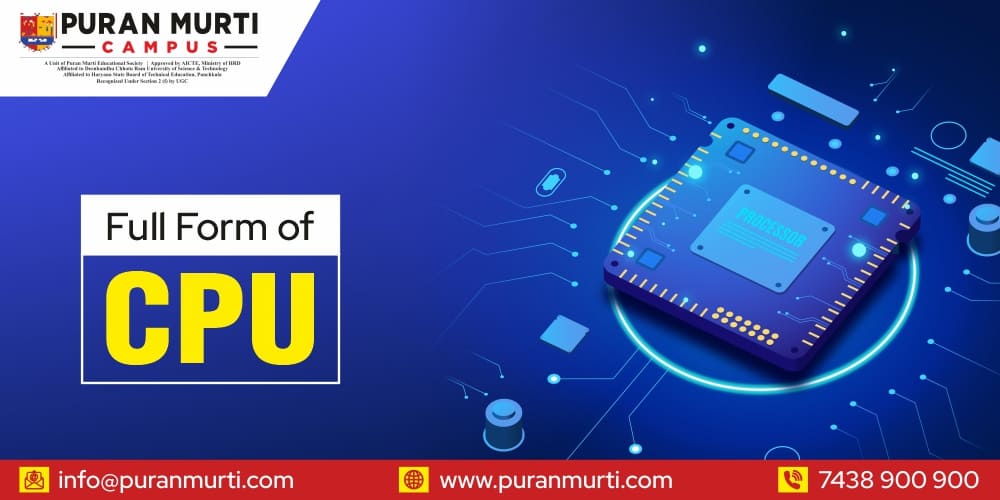Full Form of CPU
Posted on : 7 July, 2025 4:06 pm
Hi! 👋 No matter if you’re working on a laptop, desktop, tablet, or even smartphone, you definitely would have heard the Full Form of CPU. One of those “geeky” words everyone uses so often. But have you ever wondered:
👉 What is CPU short for, actually?
👉 Why do they refer to it as the “brain” of the computer?
Don’t worry — I’m going to tell you, just like a friend would, step by step.
✅ What is the Full Form of CPU?
CPU is an abbreviation for “Central Processing Unit.”
Break it down:
-
Central = middle of everything
-
Processing = performing tasks or calculations
-
Unit = individual part of a larger system
So basically, the CPU is the main unit in your system that executes all the instructions, calculations, and operations. Think of it as the “commander” that tells your computer what to do and when.
🧠 Why Do People Call the CPU the “Brain” of the Computer?
Your brain takes in information from your senses, makes decisions, and then instructs your body what to do. Likewise, the CPU takes in instructions from your applications (a game, a web browser, or a video player), executes them, and controls the computer’s other hardware so it all runs in harmony.
No matter how advanced your screen or keyboard happens to be, your computer is basically worthless without a CPU.
🛠️ What Does a CPU Do, Anyway?
Let’s explain it in simple language. Each time you:
✅ open an app
✅ type a letter
✅ click a button
✅ play music
✅ watch a video
the CPU is hard at work behind the scenes, performing millions (even billions!) of tiny instructions within seconds.
The CPU does four big things over and over again:
1️⃣ Fetch – fetches an instruction from memory
2️⃣ Decode – works out what that instruction is
3️⃣ Execute – actually performs the calculation or work
4️⃣ Store – puts the result back in memory
This gets done millions of times per second. That’s why the CPU gets a rating in GHz (Gigahertz) — i.e., how many billions of cycles per second.
🧩 What’s Inside a CPU?
While a CPU looks small outside (a tiny square chip!), it is actually very complex inside. These are its primary parts:
✨ ALU (Arithmetic Logic Unit):
The one that does all the math and logic work — adding, subtracting, comparing numbers, etc.
✨ CU (Control Unit):
Similar to a traffic cop — it directs all the data, making sure the right instructions to the right locations at the right time.
✨ Registers:
They are like small, very quick storage boxes that hold data temporarily while the CPU processes it.
✨ Cache Memory:
A small, extremely quick memory area inside the CPU so it can access data that’s often used without having to go all the way to RAM.
🔎 What Does a CPU Physically Look Like?
If you’ve ever disassembled a desktop or seen a motherboard video, the CPU is usually a small little rectangular or square chip with thousands of very small metal pins underneath (or gold contact pads). You place it carefully onto the motherboard socket, add a cooling fan on top, and it’s connected to the rest of your PC.
🚀 Types of CPUs
CPUs come in many types depending on their intended use:
✅ Desktop CPUs – intended for home or office applications
✅ Laptop CPUs – less powerful, power-saving
✅ Server CPUs – more powerful, to handle enormous data in data centers
✅ Mobile CPUs – built for smartphones and tablets
✅ Embedded CPUs – tiny chips on devices like washing machines, cars, smart TVs
🌟 How Important is the CPU?
👉 The CPU is the brain of the computer. Without it, nothing works.
👉 It runs every calculation, every click, every animation you see.
👉 Modern CPUs are amazingly powerful — the chip in your phone today is more powerful than a desk computer 20 years ago!
⚡ How is CPU Performance Measured?
Some simple terms you’ll hear:
✅ Clock Speed (GHz): how quickly in billions of cycles per second the CPU can run
✅ Cores: the number of processing units the CPU has — like having more brains in one chip (quad-core, octa-core, etc.)
✅ Threads: how many things the CPU can do at the same time
✅ Cache: fast storage for the CPU so it doesn’t lag
✅ TDP (Thermal Design Power): tells you how much heat the CPU generates, so you’ll know how to cool it
A modern CPU usually has:
👉 between 4 and 16 cores
👉 8 to 32 threads
👉 speeds of 2 GHz to 5 GHz
👉 multiple MBs of cache
That’s an awful lot of power in a chip the diameter of a coin!
🧪 Fun Fact
Did you know? The first commercially produced CPU was Intel 4004 in 1971 — and it was only a 4-bit processor running at 740 kHz (far less than 1 million cycles per second). Modern CPUs run at billions of cycles per second and have millions of times the power.🤯
📝 Quick Recap
👉 CPU full form = Central Processing Unit
👉 It is the “brain” of any computing device
👉 Executes instructions, computes mathematics, and controls the whole system
👉 Contains elements like ALU, CU, registers, and cache
👉 Available in various forms and shapes (desktop, laptop, mobile, server)
👉 Powers each click, tap, or swipe you do

